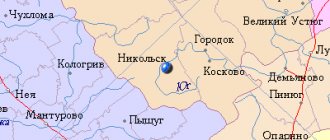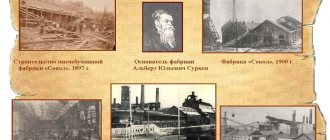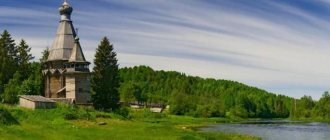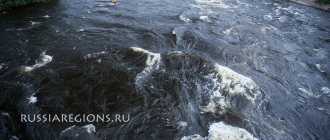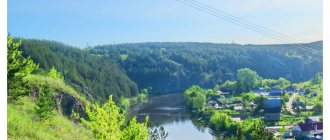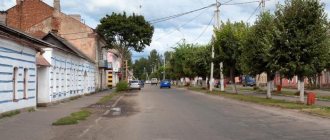The Vologda region was formed in 1937 and has more than three thousand cultural, architectural and historical monuments. Several cities are included in the list of cultural heritage of Russia, including Veliky Ustyug, Belozersk, Ustyuzhna.
The presence of mineral and peat springs contributes to the development of therapeutic and preventive sanatoriums for adults and children.
The Valdai glaciation contributed to the emergence of ancient lakes rich in fish. Due to this and the large number of forests, so-called rural tourism is being developed here, which includes hunting and fishing.
For ease of route planning, we have marked all mentioned cities and attractions on the map of the region:
Origin of the name "Vologda"
The first written evidence of settlements in the Vologda region appeared in the middle of the 13th century. In 1264 Vologda
mentioned in the Novgorod census of outlying possessions.
Temple complex - Cathedral courtyard in Veliky Ustyug
Where did the strange name come from? At the beginning of the last century, Finnish linguists Joseph Julius Mikkola and Jalo Kalima hypothesized that “Vologda” is of Vepsian origin. The ancient word “valgeda” means a river with white, that is, transparent water. The famous researcher of the Russian North, Yulia Ivanovna Chaikina, shared the same opinion.
Modern linguists question the old hypothesis, because the water in local rivers is not white and not always clear. They claim that, most likely, the unusual name arose from the word “drag”.
Pharmacy Museum
More than 340 years ago, the first pharmacy was opened in Vologda, and at that time it was the third in all of Russia. Naturally, after so many years, little remains of the original appearance of the building. However, despite this, in 2004 it was decided to open a pharmacy museum in this building on the main street. There has been nothing like this in Russia before.
The museum's exposition consists of a wide variety of things, from vessels for weighing medicines to pills and lists of Vologda folk recipes. The Museum of Pharmacy will, first of all, be of interest to lovers of object tourism, and if you combine a visit to the museum with a colorful story and tea, then everyone who decides to come here will enjoy such a vacation. Address: Lenin street-1.
Ethnographic and historical tourism
On the territory of the Kirillo-Belozersky Monastery
There are more than 760 historical monuments in the Vologda region, and many ethnographic festivals are held. Tourists enjoy going to the festival of Vepsian culture in the village of Pyazhozero, to the “Folk Herbalist” festival in Borisovo-Sudskoye, the Prokopievsky Fair in Veliky Ustyug and the Alekseevsky Fair in Verkhovazhye.
On the shore of the picturesque Siverskoye Lake is the Kirillo-Belozersky Monastery
. In terms of area, the Orthodox monastery is considered the largest in Russia. Pilgrims and lovers of Russian architecture come to see the powerful walls, towers and ancient temples of this monastery.
View of the Transfiguration Church of the Kirillo-Belozersky Monastery
If you want to see colorful competitions of Russian troikas, visit the Horse Festival in the village of Erofeyka. Fans of military reenactments enjoy the historical festival that Kirillov hosts annually. At this time, an impromptu siege is organized in the medieval fortified city, spectacular equestrian competitions and performances of historical clubs are held.
15 km from Kirilov there is an interesting open-air museum “Sugorye”. The large ethnographic complex was built in the traditions of ancient Russian estates. In “Sugorye” it’s easy to find yourself in the past of the Russian North! To do this, just visit the park, sit by the stone fireplace, shoot with a bow and crossbow, listen to the harp played and take part in a Viking feast.
Vologda Kremlin
In the village of Semenkovo, near the regional center, an unusual architectural and ethnographic museum has been opened. On the well-groomed territory there are log houses, wooden barns, a bathhouse and a chapel. Most of the exhibits are authentic. They were built at the end of the 19th – beginning of the 20th centuries and brought to the museum from different areas of the region. Inside the huts there are interesting exhibitions that tell about the main occupations of Vologda peasants, butter production, felt boots and northern hunting.
Kremlin, Vologda Historical and Architectural Museum-Reserve
Address: Vologda Kremlin (between Sergei Orlov Street, Kremlin Square and Pobedy Avenue) Phone: (8172) 72-25-11 Opening hours: from 10:00 to 17:00 (weekends - Monday, Tuesday) Cost: 100 rubles for adults, 50 – for students and schoolchildren (separately for each exhibition)
The main (and, in fact, the only) museum of Vologda is the historical, architectural and art museum-reserve. It was created in 1988 on the basis of the regional museum, but the foundation of the modern collection was laid a century earlier - in 1885. Then a house-museum of Peter I was opened in Vologda (it is still open today). A year later, an Ancient Repository was opened in the city, where religious objects and documents were collected. In 1911, an art gallery opened in Vologda, and in 1923 all the city’s museums merged into one complex. It was this, connected to the regional museum of local lore, that became a modern museum-reserve.
Now the main exhibitions of the museum are located in the buildings of the Vologda Kremlin. Although calling the modern complex the Kremlin is not entirely correct. The fact is that the real Vologda Kremlin, built as the residence of Ivan the Terrible in 1565-71, was dismantled for the construction of houses at the beginning of the 19th century.
At one time, this complex was one of the largest fortified centers in the Russian Empire. It was surrounded by wooden walls 8 meters high, earthen ramparts and artificial ditches. Inside the Kremlin there were residential buildings, chambers of commerce, warehouses, customs, a prison, a court, and, of course, sacred buildings (for example, the center of the complex - St. Sophia Cathedral). All the fortifications were badly damaged during the Time of Troubles, then they were restored, and after 3 decades, Vologda, which overflowed its banks, washed away the Kremlin. They did not rebuild the fortress a second time - it was no longer needed, and then the remains of the stone fortifications and buildings were dismantled.
But the complex mentioned now is actually the so-called Small Kremlin, the Bishop's Courtyard. It was moved to the center of the Kremlin under construction during the reign of Ivan the Terrible, and earlier the bishops' buildings stood on Lazy Square. Nowadays the Bishop's Court is one of the best preserved residences of church leaders in the country.
The buildings of the complex have never been completely rebuilt, so now visitors can observe the ensemble in its historical form. The oldest building of the Small Kremlin (Economy building) dates back to the 50s of the 17th century. The newest buildings were erected in the 19th century. Since 1923, the complex has housed a museum-reserve.
Among the exhibitions housed in the Kremlin, collections of ancient Russian painting, carved wooden sculpture, textiles and metal stand out. There are also exhibitions of numismatics, jewelry, and archaeological finds. All collections are connected by a single theme of historical and ethnographic education; during the course of the exhibitions, visitors will learn about the life of their ancestors, their activities and the history of Vologda.
Natural monuments
The hilly lands of the region lie in the taiga zone, and there are many forests of pine, fir, larch, oak, elm, maple and aspen. Near rivers and reservoirs there are spruce and blueberry trees, and alder and birch grow in abundance in the swamps.
Ferapontov Belozersky Mother of God Nativity Monastery in the village of Ferapontovo
More than 6% of the Vologda region are protected natural monuments. This includes the territory of the Russian North National Park and the Darwin Nature Reserve, old parks, groves, tracts, pine forests, geological outcrops and springs.
Tourists are welcome everywhere. Special ecological routes are laid out for travelers, and natural museums are open. If you want to stay in a national park or reserve for several days, you can stay in wooden houses or rent accommodation from local residents.
Brianchaninovs' estate in Pokrovskoye
Ferapontov Monastery
The Ferapontov Monastery is located in the Vologda region on a hill between Paskoye and Borodaevskoye lakes near the village of Ferapontovo. The beautiful architectural complex of the monastery has been a cultural and historical monument of federal significance since 1997. This place, significant for Orthodox Christians, was founded by the monk Ferapont in 1937; for more than 400 years the monastery was a major cultural and religious educational center of the Belozersky region.
At the end of the 15th century. Stone construction began on the territory of the monastery. The oldest building, the Cathedral of the Nativity of Our Lady, was built in 1490 and painted in 34 days in 1502 by the most famous temple artist Dionysius and his sons; beautiful frescoes today are the most valuable asset of the Ferapontov Monastery. Active construction was carried out in this place in the 16th-17th centuries, but the Ferapontov Monastery never became a fortress like Kirillov.
That's why the Poles ruined it in 1614, and from the end of the 17th century. The decline of this holy place begins, until in 1798 it was closed altogether. The monastery was re-opened in 1904, but as a monastery, restoration work began. After the revolution, this place was closed again and restoration was interrupted for almost 50 years, and in 1970 a museum of Dionysian frescoes was opened in its buildings. Since 2000, the beautiful ensemble of the Ferapontov Monastery has been included in the UNESCO World Heritage List.
Manor tourism
Eight ancient estates have been preserved in the region, most of which have been turned into historical and architectural museums.
Tourist and pilgrimage routes are laid through picturesque towns and villages.
28 km from the regional center stands Pokrovskoye, the family estate of the Bryanchaninov nobles. The estate was built at the beginning of the 19th century in the traditions of early classicism. Saint Ignatius (Brianchaninov) was born and spent his childhood here, so today an endless stream of pilgrims reaches Pokrovskoye. They go to learn more about the life and fate of the saint, to see the restored manorial buildings and to venerate the ashes of the Bryanchaninovs in the family necropolis.
Khvalevskoye estate in the village of Borisovo-Sudskoye
In Cherepovets there is a house-museum popular with tourists, which belonged to the famous Russian battle painter Vasily Vasilyevich Vereshchagin. The estate was built in the 30s of the 19th century, and the Vereshchagins owned it for 50 years. Now the old house displays reproductions of the artist’s paintings, which are kept in various museums around the world.
In the Vologda village of Danilovskoye there is an estate in which the poet Konstantin Nikolaevich Batyushkov and the writer Alexander Ivanovich Kuprin lived at different times. Nowadays, the main manor house has been turned into an interesting museum, and next to it, on the bank of the river, there is a green park.
The Gallsky estate in Cherepovets
Another famous estate meets tourists on the Suda River in the Babaevsky district of the region. Since the middle of the 19th century, Khvalevsky was owned by the nobles Kachalovs. Today, the descendants of this ancient family live in different cities of the country, in Riga, Paris
and
London
. Thanks to them, the manor house and the elegant Church of the Intercession were restored on Vologda land. Tourists can visit the museum room, near the source of St. Nicholas and in the beautiful park.
Opoki tract
Sukhona is the largest river in the Vologda region, famous for its rapids, rifts, and beautiful banks. The backward flow in it regularly creates floods with repeated changes of the channel at the mouth. The Opoki tract is the most dangerous and longest rapid on the river, its length is 1.5 km, the height of the banks is 60 m, and the flow speed can only be compared with mountain rivers.
On the fault, the banks of the tract look like a layer cake with brown-brown, white and dark gray stripes of clay, marls, siltstones, and limestones. These beautiful places are also known for their gushing source of ferruginous waters, and although over 50 years of mining the pressure has noticeably subsided, in winter an original ice sculpture forms near the fountain.
The nature of this beautiful place is also unique - rare plants (northern tuberous calypso orchid, clematis vine), larches, fir trees, and many species of birds have made Opoki an important natural site in the Vologda region and Russia; it was given the status of a landscape reserve at the beginning of the 21st century.
Home to Santa Claus
For two decades now, one of the oldest cities in the region, Veliky Ustyug, has been welcoming travelers from different parts of the country and from abroad.
At first, only 2 thousand tourists a year visited the estate of the main winter wizard, but ten years later their number exceeded 209 thousand people.
Santa Claus's House
People come to Veliky Ustyug to take part in the holidays and admire the beauty of northern nature. Here you can enjoy the silence, look at the cathedrals and temples of the 16th-18th centuries, as well as the ancient St. Michael the Archangel Monastery, which was founded in 1212.
The homeland of Father Frost has become so popular that tours are now organized there both in winter and summer. How did this affect the city's economy? Trade turnover increased 15 times, and unemployment fell sharply.
Climate of the Vologda region
Weather
The climate of the Vologda region is temperate continental. Winters are cold and long, summers are warm and short. Average January temperature: -14ºС in the east and -11ºС in the west, average July temperature: +16ºС in the east and +18ºС in the west. Precipitation falls about 550-600 mm per year in the west and about 500 mm per year in the east.
Best time to travel
Thanks to the mild climate, holidays in the Vologda region are good all year round. Rivers and lakes with clear water, calm and measured relaxation in cozy guest houses in the silence of the village, clean air, natural products, a Russian bathhouse with brooms, fishing, horseback riding - all this attracts lovers of rural tourism to the Vologda land at any time.
In winter, ski resorts and trails are equipped for fans of snowboarding, alpine and cross-country skiing. In the summer, the Vologda region organizes exciting trips on catamarans, boats and kayaks, bicycle rides and even off-road races “Vologda Expanses”.
These lands are famous all year round among avid hunters and fishermen. They go to these places not only for rich booty, but also for communication with the picturesque nature of the Russian North.
And those traveling with children can go to a fairy tale at any time of the year. The real Santa Claus from Veliky Ustyug is always happy to see his grandchildren, just like the mistress of the river Vashkinskaya Zolotaya Rishka, who is ready to fulfill the most cherished wishes of children and their parents for 12 months in a row.
- Church in Vologda
- Night in Vologda
- Bridge over the Vologda River
Active tourism, fishing and hunting
Lace Museum in Vologda
For those who prefer to spend their holidays in nature, there are hiking, skiing and cycling routes throughout the area. Fans of water tourism love to travel around Vologda, Sheksna, Sukhona and the South. They like to go on kayaks, catamarans and inflatable boats on the spacious Rybinsk Reservoir, Kubensky, Ladoga and White lakes.
In the Vologda region you can have a great rest, spend time in nature and go fishing. Fishing connoisseurs have many favorite places. The population density is not high, so many people enjoy fishing alone or with friends. Fishermen catch grayling, ide, chub, tench, perch and pike, and winter fishing is no less popular than summer fishing.
Spaso-Prilutsky Dimitriev Diocesan Monastery in the village of Priluki
From time immemorial, the Vologda lands have been considered the pearl of Russia, and many animals and wild birds have been preserved here. Previously, hunting was one of the main industries of local residents. Today it is one of the popular types of leisure. The region's hunting grounds extend over 14 million hectares. They are used for official hunting of elk, wild boar, bear, beaver, lynx, marten, badger, squirrel, field, hog and waterfowl.
Geography of the Vologda region
The Vologda region is located in the north of the European part of Russia, 479 km from Moscow and 683 km from St. Petersburg. In terms of area, it is one of the largest regions of the Russian Federation and accounts for almost 1 percent of its territory (145.7 thousand sq. km); the greatest length from north to south is 385 km, from west to east – 650 km.
The regional center is the city of Vologda, founded in 1147. The largest industrial center of the region is Cherepovets. The region borders in the north with Arkhangelsk, in the east with Kirov, in the south with Kostroma and Yaroslavl, in the southwest with Tver and Novgorod, in the west with Leningrad regions, and in the northwest with the Republic of Karelia. The region is divided into 26 municipal districts and 2 urban districts (Vologda and Cherepovets).
The terrain is hilly. The main lowlands are Mologo-Sheksninskaya and Prionezhskaya, the main uplands are Andomskaya, Vepsovskaya, Vologda, Verkhnevazhskaya, Galichskaya. The main rivers are Andoma, Vologda, Dvintsa, Luza, Mologa, Chagodosha, Sukhona, Unzhi, Sheksna and others. Lakes - Beloe, Vozhzhe, Kubenskoye, Onega. In the southwest of the region there is part of the Rybinsk Reservoir. The region is located in the taiga zone, forests occupy about 70 percent of its area.
- Brianchaninovs' estate
- Bell tower of the Church of St. Nicholas the Wonderworker
- Vologda churches
Souvenirs
The Vologda land is famous for its ancient folk craft - hand-made lace. The artistic features of local lace developed at the end of the 17th century. Nowadays, Vologda lace is one of the most desired gifts for women of all ages. Elegant napkins, tablecloths, scarves and collars are sold in souvenir shops and at fairs.
Museum "Submarine B-440" in the city of Vytegra
Pottery products are another type of popular souvenirs that travelers happily bring from the Vologda region. Practical and beautiful dishes are made from high-quality red clay. Vologda potters have their own secrets. To make jugs, plates and cups durable, the clay is aged under snow during the winter.
Tourists are good at examining beautiful crafts made from Vologda or Usolsk enamel. This is the name for neat color painting on white enamel. Masters skillfully draw birds, animals and floral patterns and decorate icons, boxes and jewelry with them.
Goritsky Resurrection Monastery in the village of Goritsy
What delicious souvenirs should you bring? Of course, the famous Vologda oil! The product with a soft nutty taste and original aroma is made from fresh, high-quality cream. You don't have to take packs! Shops sell souvenir oil packaged in clay pots, wooden and birch bark barrels.
| ← RUSSIA | EUROPE → |
Museum of the Metallurgical Industry
Using modern interactive technologies, the museum interestingly tells about the history of the creation of a large metallurgical center of the country. Thematic halls house interactive screens, audiovisual installations, and electronic stands. They reflect the features of the technological processes of the birth of steel from ancient times to modern times. The entire first floor is dedicated to the history of steel production.
An entertainment children's center with master classes and scientific experiments begins operating on the second floor. The museum is a modern information and educational center. Important scientific conferences are regularly held in its halls.
Address: Mira street - 42.
Memorial complex in Victory Square
To the sailors who died in all centuries . The monument was erected on this place in the summer of 1968. A complete memorial, with galleries of sculptures, the author of which was M.M. Kuznetsov, was inaugurated on May 9, 1985. Along the alley that leads to the main monument of the complex - a soldier in a raincoat with a lowered machine gun, there are busts of fellow countrymen - heroes of the Patriotic Wars.
To the dead sailors of all ages . The monument was opened in the summer of 1997 with the support of the Club of Reserve Military Sailors named after. Vice Admiral K.F. Petryashova. Memorial lists appeared here 12 years later.
Location: s. Kichmengsky Town.
Church of the Assumption of the Blessed Virgin Mary in Nelazi
Architectural monuments of ancient Russian wooden architecture, made without a single nail from beautiful, neat logs, amaze with their grandeur and originality. This is exactly what the church, built in 1694, is like. The architectural style of the church is based on an equal-pointed cross.
The center is decorated with a cross-shaped barrel. Five majestic domes rise above it. From a distance, the church resembles a mysterious ship, forever stuck among the endless fields of the Vologda region. The church is closed for regular services. You can only enter it on holidays.
Address: Nelazskoe village.
Saint Sophia Cathedral
Address: st. Sergeya Orlova, 15 Telephone Opening hours: from 10:00 to 17:00 (weekends - Monday, Tuesday) Cost: 200 rubles for adults, 100 for students and schoolchildren
The oldest stone building in Vologda is St. Sophia Cathedral. It was erected by order of Ivan the Terrible in 1568-70. The tsar took the image of the Assumption Cathedral in Moscow as a basis, so great was his desire to build a similar building in his new residence.
In 1570, a brick falls on Ivan the Terrible’s head near the entrance to the temple. Immediately all finishing work stopped - and the temple remained unfinished for 17 years. According to legend, the tsar took the fall of the stone as a bad sign and dissatisfaction with higher powers, but in reality the reason for stopping construction was most likely the abolition of the Oprichnina.
The St. Sophia Cathedral was nevertheless consecrated and decorated. It becomes the cathedral of the entire Vologda diocese in 1587. And until its closure in 1923, it remained the center of the religious life of the region. During Soviet times, a museum was located here; in 2007, the temple was opened already restored. Now the building is also listed as part of the museum-reserve, but on holidays services are held here.
The cathedral is combined into one ensemble with a bell tower, from which an impressive panorama of Vologda opens. Impressive wooden steps lead to the top of the bell tower.
